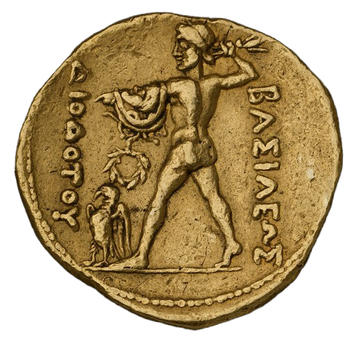COINS AT THE CROSSROADS OF ASIA
COINS AT THE CROSSROADS OF ASIA
COINS AT THE CROSSROADS OF ASIA
COINS AT THE CROSSROADS OF INDIA
PAST FREE DISPLAY
12 Nov 2022 – 7 Jan 2024
Money Gallery
Admission is FREE
History from coins?

Gold coin showing Zeus throwing thunderbolt
From around 250 BCE to 10 CE, a series of rulers controlled an area of Central and South Asia in the ancient regions of Bactria and Gandhara.
This display gives tantalising glimpses into the history of those ancient rulers and our understanding of the history of the Graeco-Bactrian and Indo-Greek kingdoms, as they are now known.
No written sources and few archaeological sites from this period survive in the region meaning that coins are, in many cases, our only historical source. While eight kings are mentioned in texts, we know of over 40 from the coins produced in their names.
Coinage was a relatively new phenomenon at the beginning of the Graeco-Bactrian kingdom. Before the arrival of Alexander the Great in Central Asia in 329 BCE, the Persians had made long, thin ‘bent bar’ coins with images stamped into either end, while coins from Ancient India looked quite different, being irregularly shaped pieces of silver stamped with many different punches. Alexander brought with him the Greek style of coinage with images on both sides, a pattern followed by the Graeco-Bactrian and Indo-Greek rulers.
In the display, you'll discover a selection of the Ashmolean’s world-leading collection of coins from this period. Learn how coinage developed at the crossroads of Asia, consider what we can understand about history when coins are our only evidence, and discover new research on these important objects.
Header images above: (1) Silver tetradrachm of Demetrius I, showing the king wearing an elephant scalp helmet, early 2nd century BCE; (2) 4th-century BCE Persian 'bent bar' coin; (3) Punch-marked coin from ancient India; (4) Silver tetradrachm of Queen Agathocleia.







